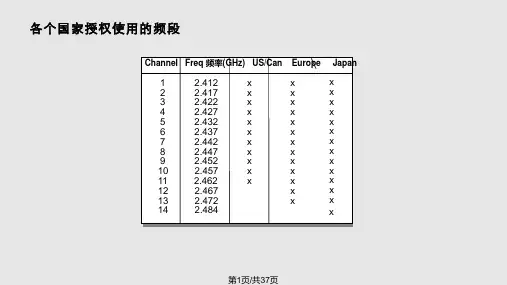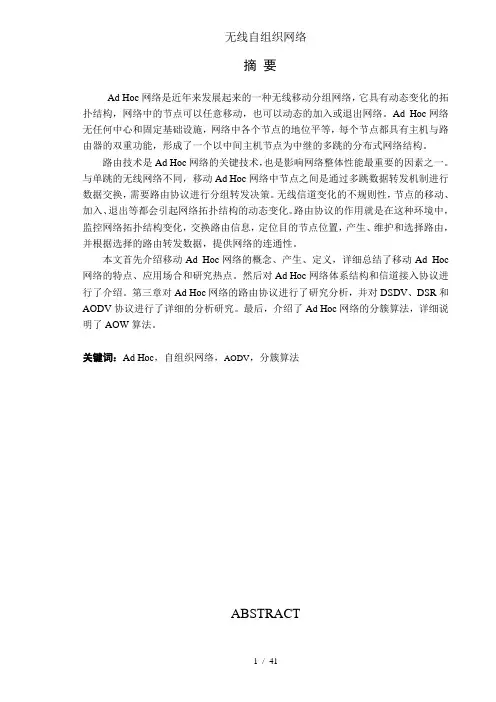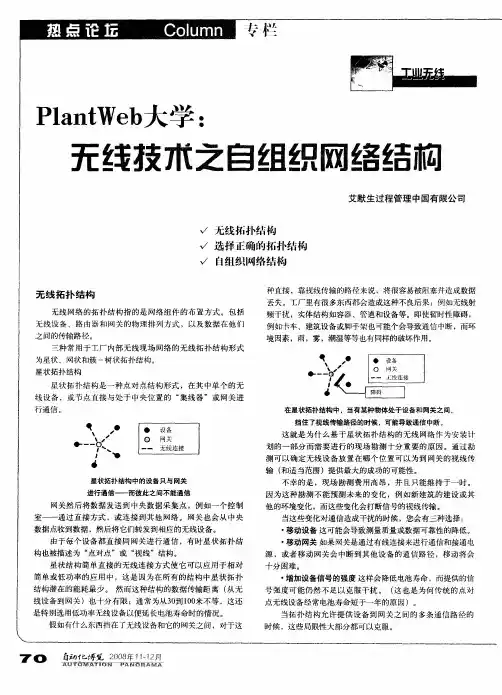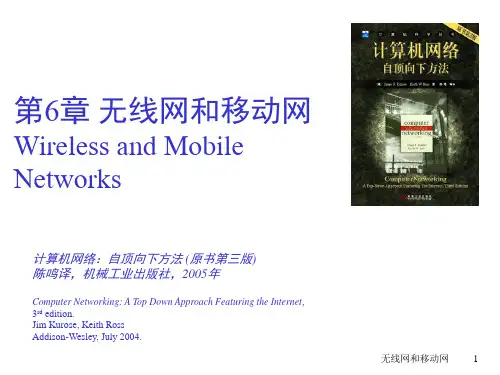第6章 无线自组织网络PPT课件
- 格式:ppt
- 大小:398.00 KB
- 文档页数:18




摘要Ad Hoc网络是近年来发展起来的一种无线移动分组网络,它具有动态变化的拓扑结构,网络中的节点可以任意移动,也可以动态的加入或退出网络。
Ad Hoc网络无任何中心和固定基础设施,网络中各个节点的地位平等,每个节点都具有主机与路由器的双重功能,形成了一个以中间主机节点为中继的多跳的分布式网络结构。
路由技术是Ad Hoc网络的关键技术,也是影响网络整体性能最重要的因素之一。
与单跳的无线网络不同,移动Ad Hoc网络中节点之间是通过多跳数据转发机制进行数据交换,需要路由协议进行分组转发决策。
无线信道变化的不规则性,节点的移动、加入、退出等都会引起网络拓扑结构的动态变化。
路由协议的作用就是在这种环境中,监控网络拓扑结构变化,交换路由信息,定位目的节点位置,产生、维护和选择路由,并根据选择的路由转发数据,提供网络的连通性。
本文首先介绍移动Ad Hoc网络的概念、产生、定义,详细总结了移动Ad Hoc 网络的特点、应用场合和研究热点。
然后对Ad Hoc网络体系结构和信道接入协议进行了介绍。
第三章对Ad Hoc网络的路由协议进行了研究分析,并对DSDV、DSR和AODV协议进行了详细的分析研究。
最后,介绍了Ad Hoc网络的分簇算法,详细说明了AOW算法。
关键词:Ad Hoc,自组织网络,AODV,分簇算法ABSTRACTAd hoc network is a kind of wireless and mobile network developed in recent years. It has a dynamic and variable topology, each node not only can move but can join or exit the network freely. It has no center and fix e d infrastructure distributed multi-hop structure,all nodes have an equal status and act as two roles-router and node itself.Routing technique is the key technique of the Ad Hoc network, but also one of the most important factors affect the performance of the whole network. It is different from single hop wireless network,mobile Ad hoc network nodes intercommunicate according to multi-hops data store-forward,which need the support of routing protocol packet forwarding decisions. The regular change of bandwidth and node motivation,pass in and out will lead to the dynamic changes of network topology. The routing protocols will monitor the changing topology,exchange routing information,locate the position of destination nodes,product, select and maintain routing, According to the selected routing and forwarding data to provide network connectivity.In this paper, first of all, introduces the concept, produce, definition of the MANET, summarizes the characteristics, applications, and research focus of the MANET. And then the Ad Hoc network architecture and the channel access protocol is introduced. In chapter 3, we researches and analysis routing protocol of the Ad Hoc network, and carried out a detailed analysis of the DSDV, DSR and AODV protocol. At last, introduces clustering algorithm of the Ad Hoc network, and detailed description of the AOW algorithm.KEY WORDS:Ad Hoc network, self-organizing network, AODV, clustering algorithm目录第一章绪论 (4)1.1A D H OC网络概述 (4)1.1.1 Ad Hoc网络的产生 (5)1.1.2 Ad Hoc网络的定义 (5)1.1.3 Ad Hoc网络的特点 (6)1.1.4 Ad Hoc网络的应用场合 (8)1.2A D H OC网络研究的主要问题 (9)1.3论文的主要研究内容 (10)第二章体系结构与信道接入 (10)2.1节点结构 (10)2.2网络结构 (11)2.3A D H OC协议栈 (13)2.4A D H OC网络体系结构的跨层设计 (13)2.4.1 设计策略 (13)2.4.2 设计方法 (14)2.4.3 跨层设计的优势与挑战 (15)2.5信道接入协议 (15)2.5.1简介 (15)2.5.2面临的问题 (15)2.5.3协议的分类 (18)第三章路由协议的设计 (19)3.1A D H OC网络路由协议的分类 (20)3.1.1平面式路由协议和分级式路由协议 (20)3.1.2表驱动路由协议和按需路由协议 (20)3.1.3 评价路由协议的标准 (21)3.1.4 各类路由协议之间的性能比较 (21)3.2几种典型的A D H OC网络路由协议 (23)3.2.1 DSDV路由协议 (23)3.2.2 DSR路由协议 (24)3.2.3 AODV路由协议 (27)第四章AD HOC网络的分簇算法 (30)4.1概述 (30)4.2基本概念和目标 (31)4.3A D H OC网络中分簇算法的分类和比较 (32)4.3.1 基于节点ID的分簇算法 (32)4.3.2 最高节点度分簇算法 (33)4.3.3 最低节点移动性分簇算法 (33)4.4自适应按需加权分簇算法(AOW) (33)4.4.1一般介绍 (33)4.4.2 AOW算法的特点和目标 (34)4.4.3算法描述 (35)4.4.4网络初始化和簇维护策略 (36)4.5基于分簇结构的A D H OC网络路由协议 (36)4.5.1 CBRP (37)4.5.2 CEDAR (37)4.5.3 ZHLS (37)总结 (38)致谢 (39)参考文献 (40)第一章绪论1.1 Ad Hoc网络概述Ad Hoc网络是一种特殊的无线移动通信网络。







自组织网络及其路由技术一、背景及概念1.发展历史无线通信网一般都是有中心的,要基于预设的网络基础架构才能运行。
例如,蜂窝移动通信系统要有基站的支持;无线局域网一般也工作在有接入点(AP)和有线骨干网的模式下。
但对于有些特殊场合来说,有中心的移动网络并不能胜任。
比如,战场上部队快速展开和推进,地震或水灾后的营救等。
这些场合的通信不能依赖于任何预设的网络设施,而需要一种能够临时快速自动组网的移动网络。
无线自组织网络即可以满足这样的应用。
自组织网络技术的研究始于20 世纪70 年代。
美国DARPA 出于军事需要,开始研究分组无线网(PRNET)在战场环境下数据通信中的应用。
项目完成之后,DAPRA 又在1993 年启动了高残存性自适应网络项目。
研究如何将PRNET的成果加以扩展,以支持更大规模的网络,还要开发能够适应战场快速变化环境下的自适应网络协议。
1994 年,DARPA 又启动了全球移动信息系统项目。
在分组无线网已有成果的基础上对能够满足军事应用需要的、可快速展开、高抗毁性的移动信息系统进行全面深入的研究,并一直持续至今。
1991 年成立的IEEE 802.11 标准委员会采用了“无线自组织网络”一词描述这种特殊的对等式无线移动网络。
美国《福布斯》杂志报道了加州大学洛杉矶分校的无线传感器网络的研究项目,指出通过无线传感器网络,我们将实实在在地掌握这个物理世界。
2003年美国《商业周刊》将无线传感器网络列为21世纪改变世界的10大技术之一。
美国《技术评论》杂志评出对世界产生深远影响的十大新兴技术,无线传感器网络排名第一。
另外,像IEEE((ComPuter》等众多杂志也都发表了一些关于无限传感器网络的论文。
我国也非常重视无线传感器网络的研究,中国国家自然科学基金委员会在2003年已经开始对无线传感器网络的研究进行了资助,并于2004年将其列为重点项目。
2005年我国开始传感网络标准化研究工作。
2006年,国家973计划,国家863高技术计划等国家和省部级科技发展“十一五”规划也设专项资助该领域的理论、方法和关键技术研究。